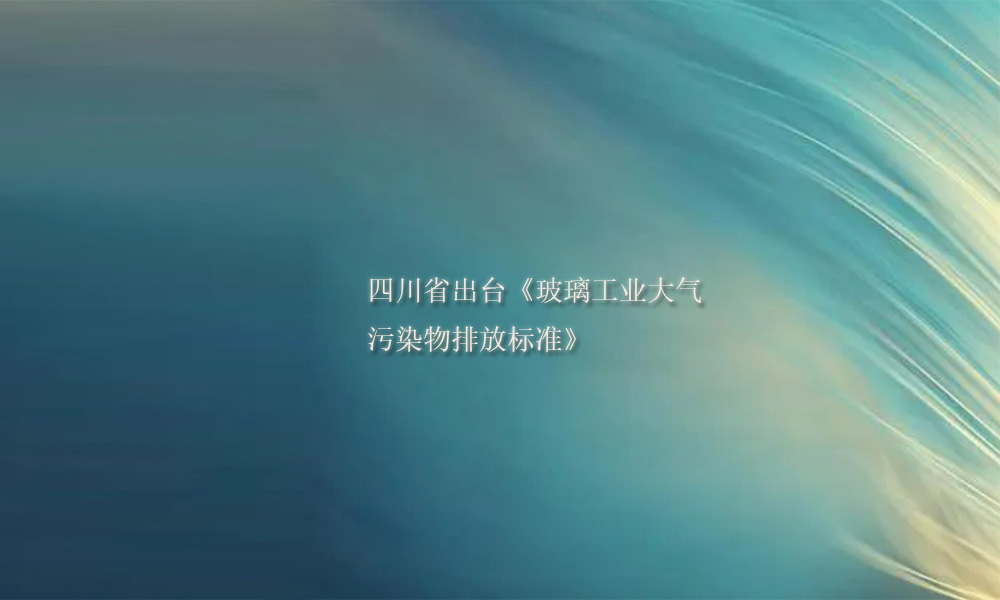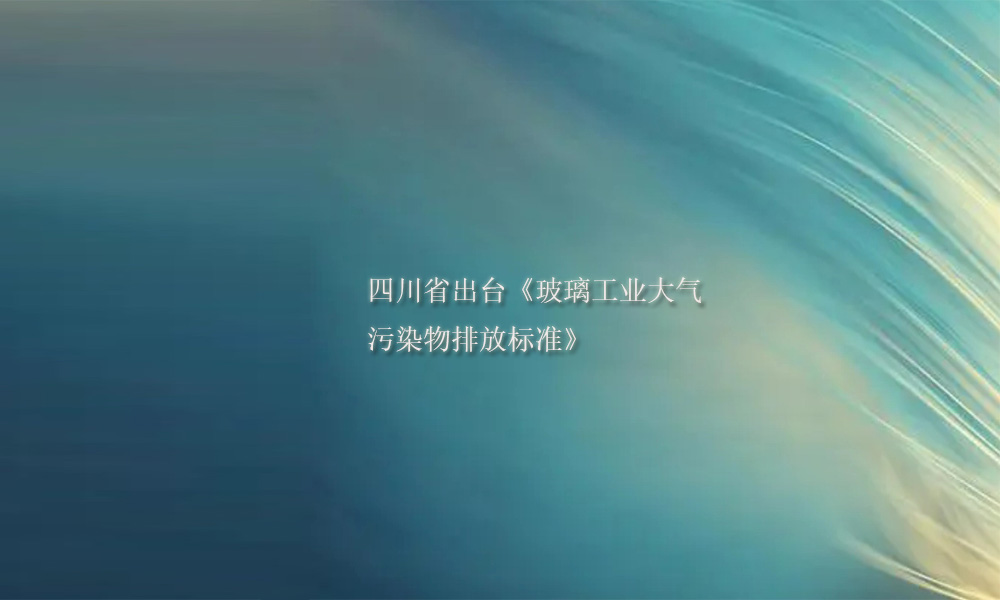Sichuan issues “Air Pollutant Emission Standards for the Glass Industry”



On the 20th, the Sichuan Department of Ecology and Environment and the Provincial Market Supervision and Administration Bureau issued the “Emission Standards for Air Pollutants in the Glass Industry”, which will be effective from October 1, 2024. implementation. So what are the principles behind this standard? What scope does it apply to? And what positive impacts will it have? Let’s take a look.
1. What is the necessity and background of formulating air pollutant emission standards for the glass industry?
The atmospheric environment situation in our province is severe, and higher standards have been put forward for the pollution control level of key industries and the scientific and refined environmental management. Require. In January 2022, the “Sichuan Province’s “14th Five-Year Plan” Ecological Environmental Protection Plan” issued by the provincial government proposed to “promote the formulation of local emission standards for pollutants such as ceramics, glass, boilers, brewing, and aquaculture tailwater.” In November 2023, the “Action Plan for Continuous Improvement of Air Quality” issued by the State Council proposed to “accelerate the improvement of air pollutant emission standards and energy consumption standards in key industries and fields. … Encourage all localities to formulate more stringent environmental standards.”
The glass industry is a traditional heavy-polluting industry and one of the important emission sources of sulfur dioxide, nitrogen oxides and fine particulate matter in the province. The nitrates and sulfates generated through secondary conversion of nitrogen oxides and sulfur dioxide are Important influencing factors of air pollution in autumn and winter. At present, the pressure to improve the environmental air quality in our province continues to increase, and we must further strengthen the pollution reduction efforts of the glass industry.
At present, the current national standards can no longer meet our province’s control requirements for air pollution emissions from the glass industry. Hebei Province, Shandong Province, Henan Province, Guangdong Province and other provinces have successively introduced more stringent local regulations for the glass industry. standard. In order to further reduce the emission of air pollutants in the glass industry and improve the quality of the atmospheric environment, the formulation of air pollutant emission standards for the glass industry is of great significance to further reduce the emission of air pollutants, improve the quality of the atmospheric environment, and promote the high-quality development of the glass industry.
2. What are the main problems faced by the current air pollution emission standards for the glass industry in Sichuan Province?
First, the emission limits of some pollutants are loose, which is not conducive to promoting technological progress in the industry and pollution prevention and control. In recent years, dust removal and desulfurization technology in our province’s glass industry has become relatively mature. SCR denitrification technology has also been promoted in the glass industry. High-efficiency management technologies such as composite ceramic filter cartridge dust removal and denitrification integration have also been gradually applied. Particulate matter, sulfur dioxide, and nitrogen oxides have Emission levels have dropped significantly. Some emission limits in GB 9078-1996, GB 26453-2011, GB 29495-2013 and GB 26453-2022 are loose and cannot play an effective restrictive role; second, pollutant control indicators are incomplete. Ammonia escapes during the denitrification process of glass furnace exhaust gas, and unorganized emissions occur in the loading, unloading, storage, and transportation of ammonia. GB 26453-2022 only stipulates the emission limit of organized ammonia, but does not establish the emission limit of unorganized ammonia.
3. What are the principles for formulating this standard?
First, the principle of cohesion. Based on the national standard GB 26453-2022 and combined with relevant national and local laws and regulations, pollutant emission limits are formulated to be equivalent to or stricter than the national standards. The second is the principle of advancement. This standard was formulated by studying the development status of pollution control technology in the glass industry in foreign developed regions, combining the current status of domestic process and technology development, based on local actual conditions, and based on the principle of promoting the progress of environmental protection technology. The third is the principle of feasibility. Combined with the region’s pollution levels and governance capabilities, fully measure the four aspects of objective science, technological feasibility, economic rationality, and operational feasibility, formulate emission standards, and promote the coordinated development of the economy and the environment.
4. What is the technical route for the formulation of this standard?
The specific technical route for the formulation of this standard is as follows: First, through data collection and research, we will understand the distribution of glass enterprises in our province, calculate the pollutant emissions of glass enterprises in the province, and determine on-site The selection principle of the survey and test ensures that the Chengdu Plain, southern Sichuan, northeastern Sichuan and western Panxi areas are covered. Secondly, flue gas and dust testing equipment is used to conduct on-site testing of the air pollutant emissions of different companies, including organized pollutant emission concentrations in different work sections and unorganized pollutant emissions at factory boundaries, to analyze the pollution emission characteristics of the glass industry and to understand key pollutant emission links. Third, use on-site surveys to understand the air pollutant control measures taken in different work sections, obtain the control efficiency of various measures through testing and research, and determine emission limits. Fourth, go to Henan, Hebei and other provinces to investigate and learn advanced technologies and management experiences in glass industry pollution control to provide reference for the formulation of standards. Finally, through consultation with experts and leaders from relevant provincial departments, municipal (state) ecological environment bureaus, universities, scientific research institutes, enterprises, industry associations and other relevant units, and repeated revisions and improvements based on feedback, the standard text was finally formed.
5. What is the scope of application of this standard?
This standard stipulates the emission limits and emission control requirements for air pollutants in the glass industry in our province, monitoring requirements and implementation and supervision requirements, applicable to the air pollutant emission management of existing glass industry enterprises or production facilities, as well as the environmental impact assessment, environmental protection facility design, completion environmental protection acceptance, and emission permit issuance of glass industry construction projects and air pollutant emission management after it is put into operation.
6. What is the basis and content of the division of different areas and work sections in this standard?
Our province has a vast territory, and there are large differences in atmospheric environment quality, industry governance status, and economic development levels in different regions. In order to fully reflect the fairness, pertinence and scientific nature of the standards, they are divided into Garze, Aba and Liangshan prefectures, as well as other cities, implement different standard limits.
Actual test data shows that the pollutant emission characteristics of different production processes are different, so they are divided into glass melting furnaces, coating exhaust gas treatment systems, and VOCs-related material processing There are four production processes including raw material weighing, batching, broken glass and other ventilation production facilities. Different production processes implement different emission limits. At the same time, taking into account the differences between different types of products, differentiated control of nitrogen oxide emission limits in cities other than Ganzi, Aba and Liangshan Prefecture is carried out. The NOx emission limit for flat glass industry is 300 mg/cubic meter; for other glass Due to the small scale of the enterprise and the relatively high installation and operation costs of denitrification facilities, the NOx emission limit for other glass is stipulated to be 350 mg/cubic meter.
7. What is the basis for determining the pollutant control items and limits in this standard?
This standard is based on the relevant national standards and the successful experience in formulating emission standards in other regions in the country, with the primary goal of protecting human health and improving the quality of the atmospheric environment, and selects relatively large emissions , and can be controlled and monitored.
The pollution emissions from glass melting furnaces are relatively complex, mainly including particulate matter, sulfur dioxide, nitrogen oxides, ammonia, hydrogen chloride, fluoride, arsenic, antimony, lead and their compounds; the coating exhaust gas treatment system mainly emits particulate matter, Hydrogen chloride, fluoride, tin and their compounds; VOCs-related material processing processes mainly emit non-methane hydrocarbons (NMHC), benzene series and benzene; raw material weighing, batching, broken glass and other ventilation production facilities mainly emit particulate matter, lead and its compounds. The standards select corresponding pollutant control projects based on the pollution emission characteristics of each production process. Actual test data shows that after the upgrade of dust removal facilities, the difference in particle concentration in each production process is small, so the same particle emission limits are implemented. Emission limits for glass melting furnaces and VOCs-related material processing processes are determined based on measured concentrations and the best treatment efficiency of pollution control facilities.
Regarding unorganized emissions, ammonia, benzene, arsenic and its compounds, lead and its compounds are mainly emitted at the enterprise boundary. Particulate matter is mainly emitted in the factory area. NMHC is also emitted around the factory building in the VOCs material processing process. The emission limit value Determined based on the measured concentration and the best treatment efficiency of pollution control facilities.
8. What positive impact will the implementation of this standard have on improving the quality of the atmospheric environment in our province?
After the implementation of this standard, the air pollutant emissions from the glass industry in all cities (states) in our province will be effectively controlled, and the quality of the urban atmospheric environment will be improved to a certain extent. Based on the province’s glass industry air pollutant emissions in 2020 as a benchmark, after the implementation of the standards, the province’s glass industry will reduce emissions by 0.85 million tons of PM10, 0.81 million tons of PM2.5, 0.84 million tons of SO2, and 0.73 million tons of NOx. The emission reduction ratio They are 60%, 60%, 75% and 50% respectively. Therefore, after the implementation of this standard, the emission of pollutants from the glass industry in our province will be greatly reduced and the environmental benefits will be significant.
amine catalyst Dabco 8154 – BDMAEE
2-ethylhexanoic-acid-potassium-CAS-3164-85-0-Dabco-K-15.pdf (bdmaee.net)
Dabco BL-11 catalyst CAS3033-62-3 Evonik Germany – BDMAEE
Polycat 9 catalyst CAS33329-35-6 Evonik Germany.pdf – BDMAEE
Dabco NE300 catalyst CAS10861-07-1 Evonik Germany.pdf (bdmaee.net)
Dabco 1027 Catalyst CAS100515-55-5 Evonik Germany – BDMAEE
Fomrez UL-28 Catalyst Dimethyltin Dioctadecanoate Momentive – BDMAEE
Polycat 77 catalyst CAS3855-32-1 Evonik Germany.pdf (bdmaee.net)
